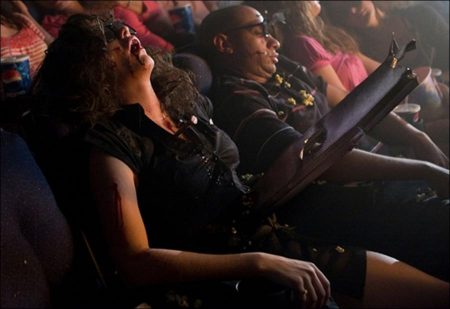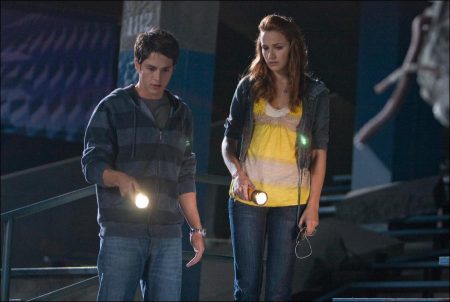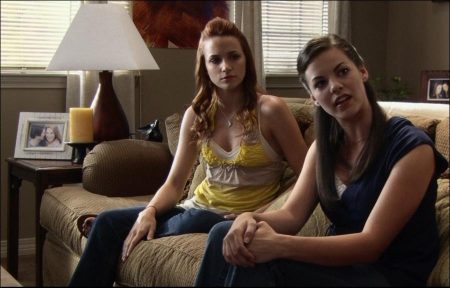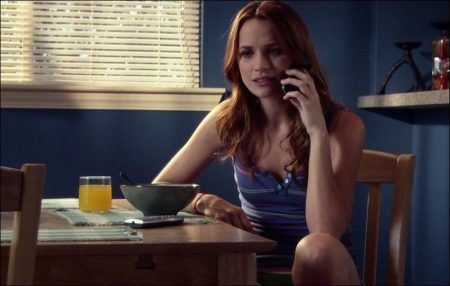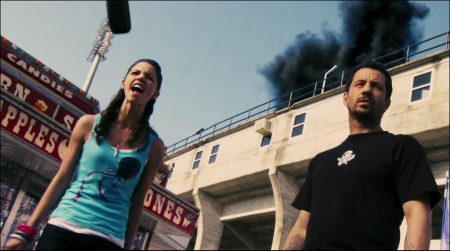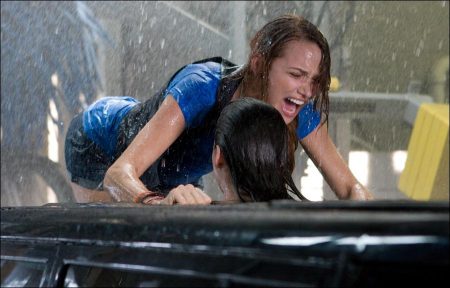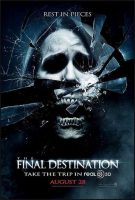Tagline: You can’t cheat death.
On what should have been a fun-filled day at the races, Nick O’Bannon has a premonition in which a bizarre sequence of events causes multiple race cars to crash, sending flaming debris into the stands, brutally killing his friends and causing the upper deck of the stands to collapse on him.
When he comes out of this grisly nightmare Nick panics, persuading his girlfriend, Lori, and their friends, Janet and Hunt, to leave… escaping seconds before Nick’s frightening vision becomes a terrible reality. Thinking they’ve cheated death, the group has a new lease on life, but unfortunately for Nick and Lori, it is only the beginning. As his premonitions continue and the crash survivors begin to die one-by-one–in increasingly gruesome ways–Nick must figure out how to cheat death once and for all before he, too, reaches his final destination.
In “The Final Destination,” the fourth installment in the successful horror series, a group of early twentysomethings cheat Death—only to have Death come back for them again and again as they keep trying to escape their fate. “The villain in the ‘Final Destination’ movies is Death,” states director David R. Ellis. “If it’s your turn to die, you’re gonna die. That’s the bottom line.” This time, Death is in 3D.
And this time around, the story centers on Nick, who, along with girlfriend Lori and friends Hunt and Janet, is out for an exciting day at the races. But as the engines rev and the cars circle the track at top speeds, Nick has a frightening premonition of an errant screwdriver falling out of the pit and onto the track, starting a domino effect that leads to a horrendous crash, sending cars hurtling into the packed bleachers. Shaken, Nick urges his friends to leave, getting them and a few others out just before his premonition becomes reality…and just before they all would have died a horrible death.
About the Production
The previous films in the series have opened with an airplane disaster, a big-rig crash and a rollercoaster catastrophe. Producer Craig Perry, who’s been the driving force behind all four rides, comments on this newest inspiration. “The ‘Final Destination’ films are known for their opening set pieces, so we tried to not only match those but hopefully take it to another level.” They decided to take it to auto racing, one of the most-viewed sporting events in the United States. “There’s a kinetic energy in racing,” Perry continues, “dangerous things can happen. But the spectators always feel removed from the danger because whatever happens usually stays in the confines of the track.”
Not in this case. “As the cars go around, one car hits a screwdriver, which pops the tires, and it starts to crash. It creates the chain reaction,” Ellis notes, referring to the famous “Final Destination” domino effect in which all major disasters begin with the tiniest, seemingly unrelated action. “Now you’ve got cars flying all over the track, into the pits, into the stands. The hoods are coming off and slicing people in half, engines fly out of cars and land on people. And when these huge pieces of metal fly into the stands, they start to take out the supports for the upper section of the bleachers, so now you’ve got those collapsing on top of people. It’s complete chaos and destruction—in 3D.”
Because Nick’s actions to save himself and his friends were not part of Death’s plan, the survivors find themselves being hunted by Death, determined to collect the souls—in the original, predetermined order—of those who were never intended to survive.
Ellis, taking a second turn at the series, isn’t the only franchise alumnus to make a return engagement. Perry felt it was the perfect opportunity to reunite the director with his “Final Destination 2” writer, Eric Bress, as both understood what needed to be accomplished and, more importantly, the need to keep the tone consistent so that fans would feel the new film remained true to the others. “Also, Eric Bress has a very sick and twisted mind and was able to bring that to the table again,” Perry says, only half-kidding. Ellis was thrilled to be involved and to have the advantage of coming into a project already knowing all the players. “It’s a very collaborative relationship,” says Ellis, “and it’s a director’s dream job because of all the incredible action sequences.”
Bress admires the director’s enthusiasm. “David Ellis is a great director for something as dark as this because, whether he admits it or not, he has a warped little child in him that jumps for joy every time there’s a little bag of blood that explodes a bit too close to the lens, or a fireball that grows too big,” Bress grins. “He just has so much fun making these films and he brings it to the set.” Bress provides an example of Ellis’ humor. “After a big stunt, where maybe two or three characters are crushed by something huge, over the loud speakers you’ll hear, ‘I’ve fallen and I can’t get up.’ There’s just so much laughter on set that I think it allows the cast to trust him more and to go further with their characters. It’s basically a party of murder and mayhem.”
Having worked with Ellis before, Bress has seen the on-set entertainment translate to the screen in a way that audiences can appreciate. “These films cater to a certain bloodlust and expectation of humor,” says Bress. “The trick is to make sure you’re giving the audience what they want. For me, writing a ‘Final Destination’ movie is about the most fun I have as a writer, especially this one because the goal was to find ways to outdo the violence in the three films that came before it, while at the same time obeying the rules of the franchise, which are less about how Death exerts its power than the relatable environments in which people die.”
“This is something else. Like Fate, maybe, or even Death. And whatever it is, it definitely wants us dead.”
Forcing the characters to think about the where and when of their mortality naturally affected their actions in the story. “Each of the characters, when confronted with death, changes slightly,” explains Perry. “Some become more cavalier about how they live their lives; others retreat and become more cautious. Our central character, Nick, becomes far more frightened about what will happen to his friends because he’s the only one who can tell what’s about to go down, so he embarks on a mission to save them. And, of course, knowing that his girlfriend is further down Death’s list, he has a vested interest in ensuring that everyone else stays alive.”
Bobby Campo plays Nick O’Bannon. “One minute Nick is sitting there with Lori, Janet and Hunt having a good time, and then the next minute he slips into a different reality and sees what’s about to happen. He becomes psychic for a moment,” says Campo, whose character is blessed—or cursed, depending on how you look at it—with being able to foresee the violent deaths of his friends…and himself.
The actor felt that the added pressure gave his character an emotional arc he was excited to explore. “Nick has just graduated from college and is at a crossroads: should he do the responsible thing by starting a career, or should he go off and experience life?” ponders Campo. “When he begins having these visions and struggling to make sense of the terrible things he sees, he starts thinking that maybe there’s a greater purpose to his life. His mission to save his friends and people he doesn’t even know becomes a journey of selfdiscovery.
Of course, this is a horror movie, so it doesn’t ever get too serious,” he assures. Perry comments, “Bobby Campo is the kind of guy that guys can like and girls will want to go out with—he has this great likeability factor. When we teamed him up with Shantel, they had great chemistry; they looked like a couple that had been going out for a long time. That is integral to the storyline of this film. We wanted audiences to root for them to survive all the death and pandemonium around them.”
Shantel VanSanten plays Nick’s girlfriend, Lori Milligan, who is no damsel in distress. “Lori is strong,” she says. “She supports Nick through these terrible visions that he’s having and tries to help him figure out the pattern so they can save the others and themselves.”
Prior to taking on the role, the actress had never seen any of the “Final Destination” films. “I’m a big scaredy cat,” VanSanten confesses. “Most of the time when I watch scary movies, I cover my eyes and leave just a little space between my fingers to look through.” Nevertheless, she can appreciate the distinct appeal of this particular series. “There’s a mystery here—Death is seeking out certain people, and you don’t know exactly why, or how it’s going to happen, or in what order. So there’s an element of surprise that keeps you on the edge of your seat the whole time thinking, ‘Is this person going to die? Is it his time?’”
Hoping it’s not her time is Lori’s best friend, Janet Cunningham, portrayed by Haley Webb. “At the beginning of the film, Janet is fairly conservative,” notes Webb. “She’s focused on being very neat and tidy and pristine, everything in its right place. But as the film progresses, she goes through a transformation. When confronted with the possibility of her own death, she realizes the way she’s been going about her life has been a bit too prudish. Instead of giving up, though, she decides to face it head on. So in a certain way, Death sets her free.”
The filmmakers thought Webb was a real find, the girl next door who’s incredibly funny and charming. Her character is pursued by would-be Romeo Hunt Wynorski, for whom they needed an actor that had the kind of confidence and quick wit that the character embodies. They found what they were looking for in Nick Zano.
Zano was already a fan of the franchise. “I don’t really think of a ‘Final’ as a horror movie. To me, it’s more of a cat-and-mouse chase with Death. It’s like trying to escape something you can’t escape.” His character, Hunt, isn’t the most likeable guy. “He’s a little crass, he’s rude, but there’s something redeemable about him. Everybody has a friend like Hunt in their life.”
“We were looking for a group of young and fresh new faces,” says Ellis. “We were really lucky to find four actors who are really dedicated to their craft and brought so much to their characters.”
Joining the young cast is veteran actor Mykelti Williamson. “We were so fortunate to get an actor of Mykelti’s stature because in many ways his character is the emotional center of the movie,” says Perry.
Williamson plays George, a security guard at the track whose life is spared the first time around when Nick has his original premonition. “I liked the script a lot,” remarks the actor. “It had heart and soul, and I was able to bring some of that to my character.” Ellis states that “there’s a lot in George’s backstory that ties into the themes the movie is exploring.”
Williamson confirms, “George is a recovering alcoholic, and there are things that he’s trying to deal with. He would love to do as much as he can for humanity because his own past mistakes are haunting him. When he sort of stumbles into these kids’ lives, he gets caught up in the whirlwind of it all and joins Nick on this journey trying to save people.”
Perry notes that the journey in “The Final Destination” is somewhat different from those in the earlier films. “We’ve added something new,” says the producer, “in that the elements in Nick’s premonitions don’t seem to directly correlate with what he encounters in reality. It then becomes a game to try and figure out how the images he sees connect with events as they unfold—or will unfold—and how these clues might help him save himself and others.”
Throwing destiny off course isn’t easily accomplished. “Nick goes through a lot of emotions in a very short period of time while running around and trying to avoid these terrible catastrophes, even though he doesn’t really understand what’s happening to him,” says Campo.
“It’s like solving a puzzle,” relates VanSanten. “We’re trying to figure out the logic in Death’s plan and convince those on his list that he’s coming for them. But to unravel the pattern of who’s going to get killed next and to get there before it’s too late… it’s a race against time.”
Nick and Lori’s race begins when their day at the track goes terribly wrong. Filming the massive and logistically and technically challenging opening sequence involved the collective expertise and effort of all departments, while shooting in two different states. An empty parking lot just over the Industrial Canal Bridge on the outskirts of New Orleans, Louisiana, was the location used to build the racetrack’s grandstands. But with no real racetrack in the immediate area, the second unit shifted over to the Mobile International Speedway in Mobile, Alabama, to shoot the actual driving sequences.
Perry offers, “We built a 140-foot section of stands in New Orleans, which matched with the real racetrack in Mobile, and then married the shots. In essence, we shot one direction of the scene in Louisiana, and the other direction in Alabama.”
Ellis is proud to reveal that “Ninety-five percent of the shots are real, with very little green screen shots in the film. The vast majority of the scenes are practical action shots with visual effects enhancements. Wherever possible, we wanted to give audiences the real deal,” he says.
Production designer Jaymes Hinkle elaborates, “We have fire, we have explosions, we have cars crashing, we have structures collapsing on people—we’ve got all kinds of crazy stuff going on. What took the longest time was probably the conceptualizing. I built a lot of models so that I could visualize it and figure out what would and wouldn’t work.”
Hinkle explains that the best approach to building the grandstands was to use foam. “We had everything cut and glued around a structure that all these foam pieces fit over. Larry Spurlock from our team came up with a compound that he could spray onto the foam to make it look like concrete. Then we aged it and built all our benches and added other elements. We probably had at least 70 guys working on it for four weeks straight. We built a 140-foot grandstand and a little strip of roadway that visual effects supervisor Erik Henry made to look 500 feet long, with two levels loaded with 14,000 people. It’s exciting bringing that all together in a seamless sequence, because ultimately you don’t want anyone in the audience to be distracted by something that doesn’t seem to match or is out of sync.”
Second unit director/stunt coordinator Jeff Dashnaw brought in several A-list stunt drivers, as well as utilizing some of the real pro drivers on the racing circuit. “When you’re doing a cannon roll down a racetrack at 80 miles an hour and working against a particular track where the bank is actually uphill, it gets tricky,” Dashnaw attests. “We had the great luck to get Buddy Joe Hooker and Mic Rodgers to come out and handle those cannon rolls, and it took a lot of stress off us knowing they were behind the wheel.”
Hooker, a member of the Hollywood Stuntmen’s Hall of Fame, is legendary in the industry—his life and work inspired the fictional character portrayed by Burt Reynolds in the 1978 stunt-themed movie “Hooper.”
For Ellis, who started out in the business as one of Hollywood’s most sought-after stuntmen, only being able to watch the racecar scenes being filmed was like being put in a “time out.” “Mobile was hard for me because I wanted to be in the cars racing around the track with all of the guys. One of the best times I had as a stuntman was working on “Days of Thunder,” driving those cars around Daytona, so my heart really wanted to be behind the wheel. I couldn’t play with them,” he sighs. “But having Buddy Joe there, who got me into films, was so great because he’s an icon in the industry and, at 66 years old, is still the best in the business.
“If these guys lose focus for even a millisecond, you scrape them off the wall with a shovel. Now that’s entertainment!” Of course, one of the greatest challenges of shooting “The Final Destination” was filming in 3D, a process that’s been around for decades, but is, with today’s advancements, entirely new.
Death has never felt more alive! Today’s high-def 3D technology, created by the PACE Fusion System, is light years ahead, delivering a moviegoing experience that offers a whole new perspective and depth of field, and that will catapult audiences into a new dimension.
Perry describes the use of the Fusion System’s revolutionary technology in “The Final Destination” as game-changing. “This franchise lends itself perfectly to 3D because of the nature of the set pieces. Now when people go see ‘The Final Destination’ they’ll feel like everything is happening not just in front of them or in their lap, but beyond the screen. They’ll be completely immersed in the frame and the world it captures.”
For Ellis, who also helmed “Final Destination 2,” the lure to return was being on the forefront of presenting audiences with a more interactive experience. “3D was definitely the pull,” he says. “I knew this would be the perfect backdrop for it and I really wanted to be involved in this new technology. I spent a lot of time researching 3D and when I heard Vince Pace and James Cameron were behind Fusion 3D, I knew it was the one.”
Vince Pace, a longtime Cameron collaborator, is passionate in his vision and notes that Fusion 3D isn’t just about delivering a product or supplying technical expertise; he views the company’s involvement in a film project as a creative relationship, where filmmakers and PACE work hand in hand collaborating on all levels of production.
Director of photography Glen MacPherson explains in layman’s terms the basic concept behind 3D. “In order to make 3D images, you need two cameras: one represents your right eye and one represents your left eye,” he says. “You must be able to point both cameras at the same subject: this is called conversion. These two images, taken at slightly different angles, become one image with the 3D glasses—in the same manner as normal human vision—to create the perception of depth.”
From MacPherson’s perspective, his camera team had their work cut out for them. “It’s certainly different from shooting a 2D movie,” he exclaims. “There’s a lot more thought process that has to go into every shot to make it work in 3D.”
In addition to the Sony F23 cameras—used for the first time for 3D filming and with the only five existing prototype 3D rigs built specifically for them—the production also had the great fortune of having the exclusive PACE Fusion Mobile Post Production Unit on site. This nondescript trailer allowed the director and the production team the advantage of being able to break tape and immediately watch a scene in perfect 3D. Instant playback meant that Ellis and MacPherson could make any necessary corrections before moving on to a new shot.
MacPherson details further how invaluable the mobile trailer was. “In the trailer there is a 3D projection system. We could actually shoot a test, run to the trailer and look at it quickly to see if we have the effect we are looking for. There are always going to be imperfections in 3D, so if one image was slightly off vertically, or if the zooms were offset, we were able to adjust all of that. It allowed us to shoot a lot faster and with confidence, knowing that we could go at the end of the day and adjust any of those glitches.”
Once the actors got a taste of watching scenes in the trailer, it was hard to get them out, but as Mykelti Williamson says, not only was the “cool factor” huge, it also became a useful tool in the acting process.
“I tried not to abuse going into the trailer, but it really helped me to stay in that world of 3D,” recounts Williamson. “Once you saw how much your perception changed, you got so excited about this new world that you wanted to race back to work because you wanted to shoot more to be able to see more. With this technology and the way the glasses have advanced, you forget you have the glasses on and instead you actually feel like you’re looking into somebody’s life, and they don’t know that you’re there. I was really impressed.”
Ellis originally made a name for himself as one of the industry’s most respected second unit directors working on big, expansive action-driven scenes. On “The Final Destination,” he used the 3D technology to create frighteningly immersive action sequences, including the opening racetrack scene.
MacPherson offers, “David wanted to make a really fun and entertaining film without being limited by the 3D technology. We had to come up with ways to make those action scenes work, which hasn’t been an easy feat. We had to put these big, 3D camera rigs in some really small, tight areas. We mounted them on a steadicam or went hand-held; we completely submerged them in a swimming pool and dropped them with descender rigs from buildings; we had them near fire and explosions; and for the racetrack scenes, we mounted these cameras on a motocam-arm on a car while running around the track at 100 miles an hour. We put these cameras in a lot of places where I don’t think anybody has ever put a 3D camera before—especially not these new models.”
“Even before we started shooting, we put camera mounts on cars in an empty parking lot at Magic Mountain so we could see how they would react, since the big opening scene is at a racetrack. We found the vibration of the cars threw the alignment of the cameras off because they are so sensitive, so we couldn’t hard-mount cameras to the racecars. For the most part, we had the cameras in an independent car so they could be stabilized, but, that said, we never lost real time with this equipment,” admires Ellis. “I think that speaks a lot about our crew and the support we got from Vince.”
“Mind if my girl uses your binoculars?”
You can’t cheat Death… or high-def. Production elements, including make-up, special effects, visual effects and set designs, had to be crafted with high-definition 3D in mind.
For KNB EFX on-set project supervisor Mike McCarty who oversaw the special effects make-up, the high-def 3D had its own particular set of challenges, beginning, of course, with the requisite blood. “High-def has a different color palette than regular film,” notes McCarty. “High-def tends to run things a little bit more orange, so in the beginning, our blood looked like the old blood like they used in the `70s and `80s. We had to darken everything and make it look almost like dried blood. Normally you might over-paint something or do something a little bit more theatrical for film so that it stands out, as opposed to looking perfect to the naked eye. But that’s what high-def needs; it picks up everything.”
Production designer Hinkle also had to wrap his head around creating sets that worked practically for the scenes but held up to the visual scrutiny of 3D in high-def. “It was an enormous challenge at the very beginning. We were experimenting with the cameras and did a couple of tests to determine the spatial relationship between the camera, the actors, the back wall, the side walls and the foreground, all of those things. Gradually, as Glen McPherson and I began to collaborate more and more on how we were going to do it, the sets became bigger and bigger. And when I say bigger, I mean in the physical sense; they expanded out primarily to allow for the room you needed between the camera, the actor and everything else within the room. We had some wonderful sequences that became huge undertakings.”
Perry adds, “High-def is an incredibly unforgiving format. You can see everything. For instance, for added ‘extras’ in a crowd scene, either cutouts or blow-up dolls are sometimes used instead of real people. But with 3D the cutouts looked flat and in HD the blow-ups looked fake, even though they have contours. There’s a clarity and crispness on the screen. There’s no way you can cheat.”
Both 3D and high-def are about making the environment on the screen feel as real as it can be, with visuals becoming more lifelike and therefore engaging more of our senses. Visual effects supervisor Erik Henry quickly realized that shooting in 3D meant rethinking absolutely everything.
“What I learned from talking with Vince Pace is that the future of 3D isn’t so much about the gimmicks, like things flying at you,” Henry says. “The future is composing a shot in a manner that mimics the depth we would experience if we were there live. A shot in 3D becomes more interesting because 3D has made the shot more realistic. I’ve worked in the 2D world for 20 years and the tiniest things you take for granted don’t typically work in 3D,” he notes. “A big challenge for us was in compositing the visual effect shots—where normally we create a matte or remove something from a frame for 2D, now, because you have two cameras that are in different positions, we have to completely redo the matte or remove artifacts from the removed object for the second camera, or ‘eye.’ In other words, there’s no easy way out trying to copy work from one eye to the other eye.”
Despite the added efforts, Henry found the close collaboration of visual effects with stunts, special effects, make-up effects and other production team members a rewarding experience. “All the visual effects shots are incredibly complicated, but it was great to have the collaboration from all departments. Everything overlapped and it took all of us to figure out how to do things the best way.”
Even though from a technical perspective working in 3D was exciting, from a storytelling perspective the filmmakers were adamant that character arcs and story points didn’t cater to the 3D element. The film had to work as a great, straight-ahead 2D experience. Therefore they essentially shot two movies, one that’s 2D and one that’s in 3D. “The reality is there are still a limited number of screens out there,” states Ellis. “Bottom line for me, this movie has to have a great story and characters that you invest in. It has to stand on its own in 2D. If it’s scary in 2D, then it’s going to be horrifying in 3D.”
Perry adds, “Vince Pace was able to impart a philosophy about capturing images and telling stories to our entire team, which has served this movie unbelievably well. While things popping out at you are cool, 3D needs to be a storytelling tool, not just a device. You want to be very strategic about how you apply it.”
The filmmakers found there was so much depth to a shot that it felt like real life playing out in front of them. In one scene, for instance, Williamson’s character, George, is talking about his life to Nick and Lori. “You feel like you’re sitting next to him on the couch, listening to him. Audiences aren’t going to expect how powerful 3D can be in those quieter moments,” says Ellis.
Writer Eric Bress notes, “These films always play best in front of a full audience, because there’s something contagious about the scares as well as the laughs. Now more than ever, the audience will really be a part of some great shared experience as the heightened reality pulls them ever closer toward Death’s reach.”
“If you’re right about this whole crash thing, I want to make the most of every moment I’ve got left. I might be next, right?”
With 3D allowing Death to almost literally reach out into the audience, “The Final Destination” plays into the belief that some people are far more scared about how they’ll die than when. “I think the moment you personify death as an actual figure, you take away a little bit of the mystery,” comments producer Craig Perry. “In the ‘Final Destination’ movies, you don’t see a slasher, there’s no actual body coming after you, so it feeds into the notion of what death may or may not be for each individual person. That’s something that everyone has questions about at some point in their life, and ‘The Final Destination,’ with its invisible killer, plays on everybody’s own personal fears.”
Actor Bobby Campo offers, “In life, we’re all in a contest against Death, which is this unstoppable force. In this movie, we’re the underdogs trying to cheat Death, which is what a lot of people wish they could do. I think everyone on the set had their own ‘Final Destination’ moment, where they realized that at any time in life, the simplest thing can go terribly wrong.”
Shantel VanSanten says, “Sometimes now I’ll wonder, ‘If I hit that pencil on the desk, and if it rolls off into the floor, will it hit that board and come smack me in the face?’ I’ll think about random series of events now when I see something that may not look at all dangerous, how it could possibly kill me,” she laughs. “Because these are everyday moments that they portray in the movies…and you never know. That’s what freaks people out.”
Of the especially freaky moments, Webb recounts, “In some of my scenes, that wasn’t acting. David and the crew made things look so real that there were a couple of times when there was so much adrenaline, I almost forgot there were all these people around making sure I was safe and recording my perils for entertainment.”
“What’s great about the ‘Final Destination’ movies is when you’re watching a scene and thinking, ‘Okay, there are four ways he could die here.’ But it’s the fifth way you never saw coming that completely blows your mind. And we have a lot of them in this film,” smiles Nick Zano.
Director David R. Ellis adds, “Sometimes we try to misdirect the audience, which is all part of the fun and thrill factor in these films. It’s those surprise elements that fans love to experience and one of the reasons this franchise has been so popular.”
The Final Destination 4 (2009)
Directed by: David Ellis
Starring: Bobby Campo, Shantel VanSanten, Krista Allen, Mykelti Williamson, Haley Webb, Nick Zano, Andrew Fiscella, Richard T. Jones, Stephanie Honoré, Lara Grice, William Aguillard
Screenplay by: Eric Bress
Production Design by: Jaymes Hinkle
Cinematography by: Glen MacPherson
Film Editing by: Mark Stevens
Costume Design by: Claire Breaux
Set Decoration by: Raymond Pumilia, John Tegethoff
Art Direction by: Scott Plauche
Music by: Brian Tyler
MPAA Rating: R for strong violent / gruesome accidents, language and a scene of sexuality.
Distributed by: New Line Cinema
Release Date: August 28, 2009
Visits: 220
